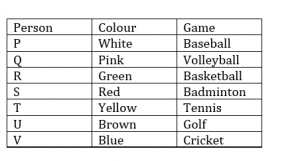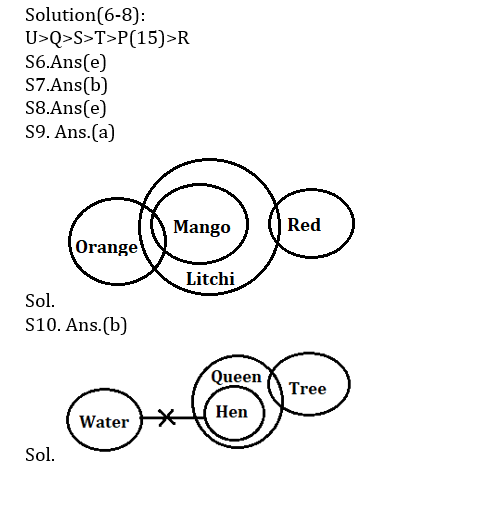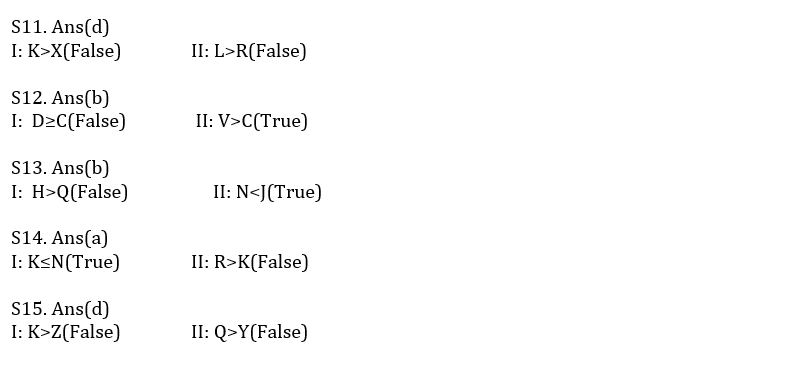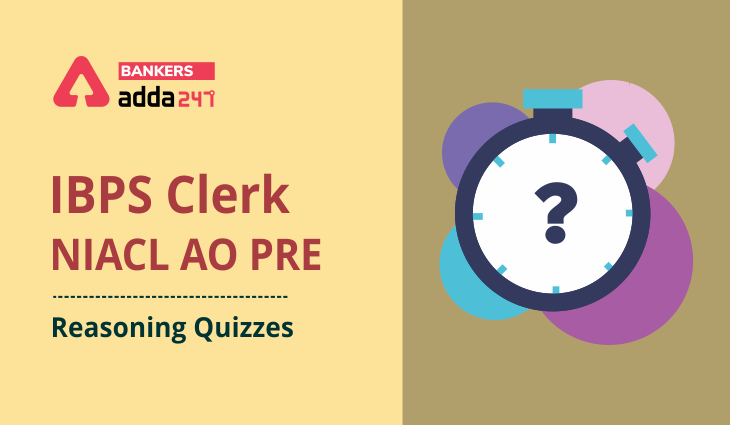Directions (1-5): Study the information carefully and answer the questions given below
Seven persons P,Q, R, S, T, U and V play different games Volleyball, Tennis, Cricket, Golf, Baseball, Badminton and Basketball. They all like different colours i.e. White, Brown, Pink, Red, Yellow, Green and Blue. All information is not necessarily in same order.
S likes Red colour and Play badminton. T does not play Golf and Volleyball. The one who likes yellow colour does not play cricket. P plays baseball and does not like Pink and brown colour. The one who likes green colour play Basketball. T likes yellow colour. V likes Blue colour and does not play Golf and Volleyball. U likes brown colour. Q plays Volleyball.
Q1. Who among the following likes pink colour?
(a) P
(b) R
(c) U
(d) T
(e) None of these
Q2. Which of the following person play Golf?
(a) Q
(b) S
(c) U
(d) T
(e) None of these
Q3. Which of the following combination is true?
(a) T-Golf
(b) R-Basketball
(c) S-Tennis
(d) V-Badminton
(e) None is true
Q4. Who among the following play Basketball?
(a) P
(b) S
(c) R
(d) T
(e) None of these
Q5.Which of the following given statement is true?
I. T likes yellow colour and play Golf
II. P plays baseball
III. U likes brown colour
(a) Only I
(b) Only I and II
(c) Only II and III
(d) Only II
(e) None is true
Directions (6-8): Study the following information carefully and answer the given questions.
Amongst Six persons, P,Q R, S, T and U, each has different ages. T’s age is more than P and R. Q is older than S. Only three persons are younger than S. P is not the youngest employee. The age second youngest is 15yrs. U is older than Q.
Q6. Who among the following is eldest?
(a) S
(b) Q
(c) R
(d) P
(e) None of these
Q7. How many persons older than T?
(a) One
(b) Three
(c) Two
(d) More than three
(e) None
Q8. If S age 36 years than what may be the age of Q?
(a) 24yr
(b) 48yr
(c) 40yr
(d) 9yr
(e) Can’t be determined
Directions (9-10): In each of the questions below are given some statements followed by some Conclusions. You have to take the given statements to be true even, if they seem to be at variance from commonly known facts. Read all the conclusions and then decide which of the given conclusions logically follows from the given statements disregarding commonly known facts.
Q9. Statements:
Some Orange are Mango
All Mango are Litchi
Some litchi are Red
Conclusions:
I. Some litchi are Orange
II. Some Red are mango
(a) If only conclusion I follows.
(b) If only conclusion II follows.
(c) If either conclusion I or II follows.
(d) If neither conclusion I nor II follows.
(e) If both conclusions I and II follow.
Q10. Statements:
No water is hen
All hen are Queen
Some Queen are Tree
Conclusions:
I. .Some tree are not water
II. Some queen are not water
(a) If only conclusion I follows.
(b) If only conclusion II follows.
(c) If either conclusion I or II follows.
(d) If neither conclusion I nor II follows.
(e) If both conclusions I and II follow.
Directions (11-15): In these questions, relationship between different elements is show in the statements. The statements are followed by conclusions. Study the conclusions based on the given statements and select the appropriate answer:
Q11. Statements: V>J>X<L=F≥R<U<Q≤K
Conclusion I: K>X II: L>R
(a) If only conclusion I follows.
(b) If only conclusion II follows.
(c) If either conclusion I or II follows
(d) If neither conclusion I nor II follows.
(e) If both conclusions I and II follow.
Q12. Statements: D>R=L>C<N≤V>F<L
Conclusion I: D≥C II: V>C
(a) If only conclusion I follows.
(b) If only conclusion II follows.
(c) If either conclusion I or II follows
(d) If neither conclusion I nor II follows.
(e) If both conclusions I and II follow.
Q13. Statements: H≥B=Q>I<J>S>N≤L
Conclusion I: H>Q II: N<J
(a) If only conclusion I follows.
(b) If only conclusion II follows.
(c) If either conclusion I or II follows
(d) If neither conclusion I nor II follows.
(e) If both conclusions I and II follow.
Q14. Statements: C<N=F≥K>E<T≤R≥Y
Conclusion I: K≤N II: R>K
(a) If only conclusion I follows.
(b) If only conclusion II follows.
(c) If either conclusion I or II follows
(d) If neither conclusion I nor II follows.
(e) If both conclusions I and II follow.
Q15. Statements: Y>Z>U>Q≤K≥L=Q
Conclusion I: K>Z II: Q>Y
(a) If only conclusion I follows.
(b) If only conclusion II follows.
(c) If either conclusion I or II follows
(d) If neither conclusion I nor II follows.
(e) If both conclusions I and II follow.
Solutions
Solution(1-5):

S1.Ans.(e)
S2.Ans(c)
S3.Ans(b)
S4.Ans(c)
S5.Ans(c)


Click Here to Register for Bank Exams 2021 Preparation Material





 GA Capsule for SBI Clerk Mains 2025, Dow...
GA Capsule for SBI Clerk Mains 2025, Dow...
 The Hindu Review October 2022: Download ...
The Hindu Review October 2022: Download ...
 Delhi CSIR CRRI Recruitment 2025 Notific...
Delhi CSIR CRRI Recruitment 2025 Notific...







